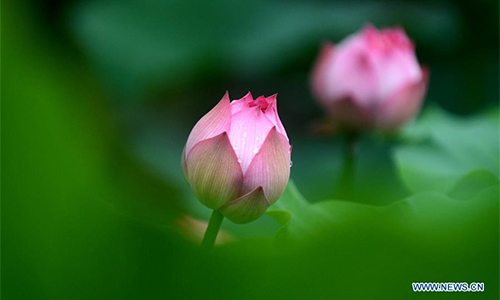
Lotus flowers are seen after rain at a park in Yangzhou, east China's Jiangsu Province, Sept. 6, 2017. (Xinhua/Meng Delong)
China unveiled on Monday an ancient lotus stone found in Xingtai's Shahe Town North China's Hebei Province dating back as much as 400 years and is providing important historical research value for water ecosystems. It reflects the abundance of water resources and the ecological environment in this area at that time.
The tablet, whose text is written in regular script, bears the lotuses poems by Li Tingxiu, from the Ming Dynasty (1368-1644).
The tablet is made from limestone, and is basically well-preserved. The unearthed part were the body and pedestal of the tablet, and the top part has not yet been unearthed, but could still be recreated into the scene of the lotuses displayed everywhere.
Shahe Town has a long history of planting lotus roots. During the Ming Dynasty, planted lotus roots could be found everywhere, there were thousands of lotuses bloomed at that time like the beautiful scenery of Jiangnan, or Southern China. Poet Su Dongpo and other famous historical figures have praised the lotus in Shahe Town, according to media reports.
Deputy researcher Zhang Guoyong from Xingtai Cultural Relics Protection and Research Center told the Global Times on Tuesday that the tablet approved the history of lotus planting in Ming and Qing Dynasties (1644-1911) to provide the rare physical historical materials for researching local lotus cultivation and it has also played a key role in supplementing the historical materials.
Zhao Mengkui, cultural studies specialist believed that the unearthed tablet showcases the important value for researching Ming Dynasty's human landscape, calligraphy and sculpture and lotus culture.
There were many fruitful archaeological discoveries in Xingtai.
In May, an ancient stone tablet from the Qianlong era (1736-95) of the Qing Dynasty was found in Xingtai, witnessing the history of the migration of people from the area south of Beijing and Tianjin.
URL: https://www.seeglobalnews.com/read-1956.html